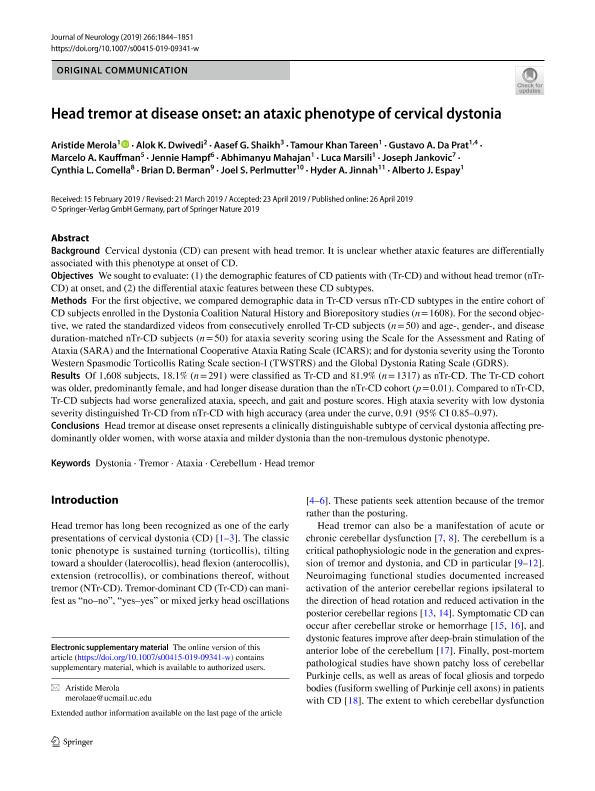Artículo
Head tremor at disease onset: an ataxic phenotype of cervical dystonia
Merola, Aristide; Dwivedi, Alok K.; Shaikh, Aasef G.; Tareen, Tamour Khan; Da Prat, Gustavo A.; Kauffman, Marcelo Andres ; Hampf, Jennie; Mahajan, Abhimanyu; Marsili, Luca; Jankovic, Joseph; Comella, Cynthia L.; Berman, Brian D.; Perlmutter, Joel S.; Jinnah, Hyder A.; Espay, Alberto J.
; Hampf, Jennie; Mahajan, Abhimanyu; Marsili, Luca; Jankovic, Joseph; Comella, Cynthia L.; Berman, Brian D.; Perlmutter, Joel S.; Jinnah, Hyder A.; Espay, Alberto J.
 ; Hampf, Jennie; Mahajan, Abhimanyu; Marsili, Luca; Jankovic, Joseph; Comella, Cynthia L.; Berman, Brian D.; Perlmutter, Joel S.; Jinnah, Hyder A.; Espay, Alberto J.
; Hampf, Jennie; Mahajan, Abhimanyu; Marsili, Luca; Jankovic, Joseph; Comella, Cynthia L.; Berman, Brian D.; Perlmutter, Joel S.; Jinnah, Hyder A.; Espay, Alberto J.
Fecha de publicación:
08/2019
Editorial:
Dr. Dietrich Steinkopff Verlag
Revista:
Journal of Neurology
ISSN:
0340-5354
Idioma:
Inglés
Tipo de recurso:
Artículo publicado
Clasificación temática:
Resumen
Background: Cervical dystonia (CD) can present with head tremor. It is unclear whether ataxic features are differentially associated with this phenotype at onset of CD. Objectives: We sought to evaluate: (1) the demographic features of CD patients with (Tr-CD) and without head tremor (nTr-CD) at onset, and (2) the differential ataxic features between these CD subtypes. Methods: For the first objective, we compared demographic data in Tr-CD versus nTr-CD subtypes in the entire cohort of CD subjects enrolled in the Dystonia Coalition Natural History and Biorepository studies (n = 1608). For the second objective, we rated the standardized videos from consecutively enrolled Tr-CD subjects (n = 50) and age-, gender-, and disease duration-matched nTr-CD subjects (n = 50) for ataxia severity scoring using the Scale for the Assessment and Rating of Ataxia (SARA) and the International Cooperative Ataxia Rating Scale (ICARS); and for dystonia severity using the Toronto Western Spasmodic Torticollis Rating Scale section-I (TWSTRS) and the Global Dystonia Rating Scale (GDRS). Results: Of 1,608 subjects, 18.1% (n = 291) were classified as Tr-CD and 81.9% (n = 1317) as nTr-CD. The Tr-CD cohort was older, predominantly female, and had longer disease duration than the nTr-CD cohort (p = 0.01). Compared to nTr-CD, Tr-CD subjects had worse generalized ataxia, speech, and gait and posture scores. High ataxia severity with low dystonia severity distinguished Tr-CD from nTr-CD with high accuracy (area under the curve, 0.91 (95% CI 0.85?0.97). Conclusions: Head tremor at disease onset represents a clinically distinguishable subtype of cervical dystonia affecting predominantly older women, with worse ataxia and milder dystonia than the non-tremulous dystonic phenotype.
Palabras clave:
ATAXIA
,
CEREBELLUM
,
DYSTONIA
,
HEAD TREMOR
,
TREMOR
Archivos asociados
Licencia
Identificadores
Colecciones
Articulos(IIMT)
Articulos de INSTITUTO DE INVESTIGACIONES EN MEDICINA TRASLACIONAL
Articulos de INSTITUTO DE INVESTIGACIONES EN MEDICINA TRASLACIONAL
Citación
Merola, Aristide; Dwivedi, Alok K.; Shaikh, Aasef G.; Tareen, Tamour Khan; Da Prat, Gustavo A.; et al.; Head tremor at disease onset: an ataxic phenotype of cervical dystonia; Dr. Dietrich Steinkopff Verlag; Journal of Neurology; 266; 8; 8-2019; 1844-1851
Compartir
Altmétricas



